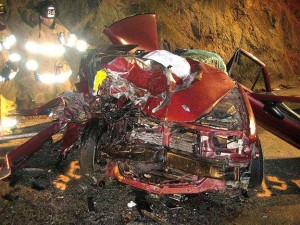
Toyota has begun to settle at least some wrongful injury and death claims rather than drag the fight out.
Toyota Motor Co. is pushing to settle a series of wrongful death lawsuits in which the plaintiffs appear to have a solid chance of proving to a jury that unintended acceleration-related design flaws contributed to the accidents.
The company maintains stuck floor mats and driver error are the reasons for vehicles unexpectedly surging out of control, while plaintiffs’ attorneys contend Toyota’s electronic throttle control system is to blame.
In the first critical step, Toyota has elected to settle a wrongful death suit in Utah. The company said Thursday that it came to terms with the family of two people killed in a Utah crash that was set to go to trial next month and might have served as a test case for hundreds of other lawsuits that are pending.
Terms of the settlement agreement weren’t released. But it comes barely a month after Toyota announced it would spend more than $1 billion to settle lawsuits in which vehicle owners claimed the value of their Toyota products had dropped due to the controversy over unintended acceleration.
In the Utah case, Toyota issued a statement saying that the company and its attorneys may decide to settle select cases, but “we will have a number of other opportunities to defend our product at trial.”
“We sympathize with anyone in an accident involving one of our vehicles,” the statement said, “however we continue to stand fully behind the safety and integrity of Toyota’s Electronic Throttle Control System, which multiple independent evaluations have confirmed as safe.”
Even so, American juries are unpredictable and Toyota apparently doesn’t want to have to defend itself in the unintended acceleration cases in front of a jury. A loss in one of the more gruesome cases could do serious damage to the company’s reputation, experts said.
The Utah case involved the death of Paul Van Alfen and his son’s fiancée, Charlene Jones Lloyd They were killed when their Camry slammed into a wall near Wendover, Utah, in 2010. The Utah Highway Patrol concluded, based on statements from witnesses and crash survivors, that the gas pedal was stuck.
The automaker initially denied reports that its vehicles suffered any problems with unintended acceleration but reversed itself and ordered a massive recall in late 2009 following a crash that killed a California Highway Patrol and several family members. That action covered loose floor carpets that could jam the accelerator pedal. But months later the maker followed with a second recall involving sticky throttles.
The National Highway Traffic Safety Administration has issued a series of fines against Toyota – including a record penalty last year of $17.4 million — for failing to quickly report problems to federal regulators and for delaying safety recall. The latest unintended acceleration-related problem involved more than 150,000 2010 Lexus Rx 350s and RX 450h models because the driver’s-side floor mats can trap the gas pedal and cause the vehicles to speed up without warning.
On the other hand, a series of studies conducted for NHTSA, including one undertaken by NASA, failed to uncover any electronic control issues.
And so far, the attacks haven’t dented the company’s reputation. If anything, Toyota enjoyed its strongest sales upsurge in years during 2012 and hopes for a repeat this year.
“Our new, more dynamic product designs are helping us bring in younger buyers. For example, thanks to the sportier SE model, the median age for our Camry buyers dropped by almost a decade to 51 years old,” Jim Lentz, president and chief executive officer of Toyota Motor Sales proclaimed during the North American International Auto Show last week.
He also told a conference sponsored by Deutsche Bank he expected Toyota’s sales to crew by 100,000 units this year despite its legal battle – and other safety-related issues.
Toyota has recalled more than 14 million vehicles globally to fix sticky gas pedals and floor mats. That is one reason why company also has recalled more vehicles than any manufacturer operating in the U.S. market for three of the last four years, including 2012.

Pigs will fly before anyone can prove that current model autos have legitimate “unintended acceleration”. It simply does not happen now any more than it did for the Audi 5000 back in the 80’s or 90’s when the first bogus lawsuits were filed.
No one ever proved “unintended acceleration” because it didn’t happen. It was driver error then and driver error now. Period. If you understand the fail-safe design of the DBW, you’d know it is simply impossible for unintended acceleration to occur.
Most people don’t want to accept the reality that they caused the accident. In the U.S. you sue for jackpot justice as there is a good chance of getting money out of companies with deep pockets. The reason you get money isn’t because you can prove your claims, it’s because U.S. juries and many judges are technically illiterate. A car maker doesn’t want to take a chance of a bogus judgment against them setting a precedent, otherwise every car owner will sue for jackpot justice based on the original bogus judgment against the car maker. Welcome to the Land of Litigation… where corrupt lawyers and plaintiffs cash-in all the time.
Why is it that alleged “unintended acceleration” lawsuits only happen in the U.S. Is the air so bad here that it causes cars to drive by themselves? I don’t think so…